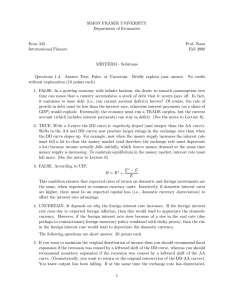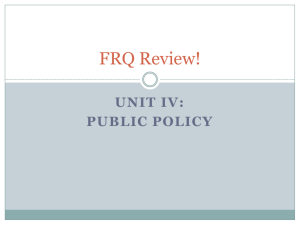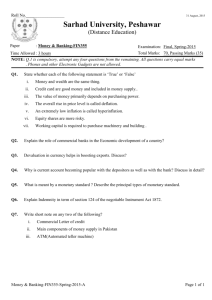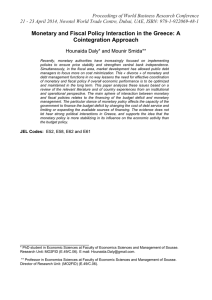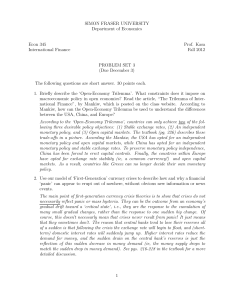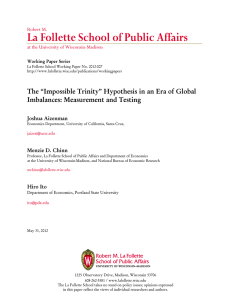SIMON FRASER UNIVERSITY Department of Economics Econ 345 Prof. Kasa
advertisement
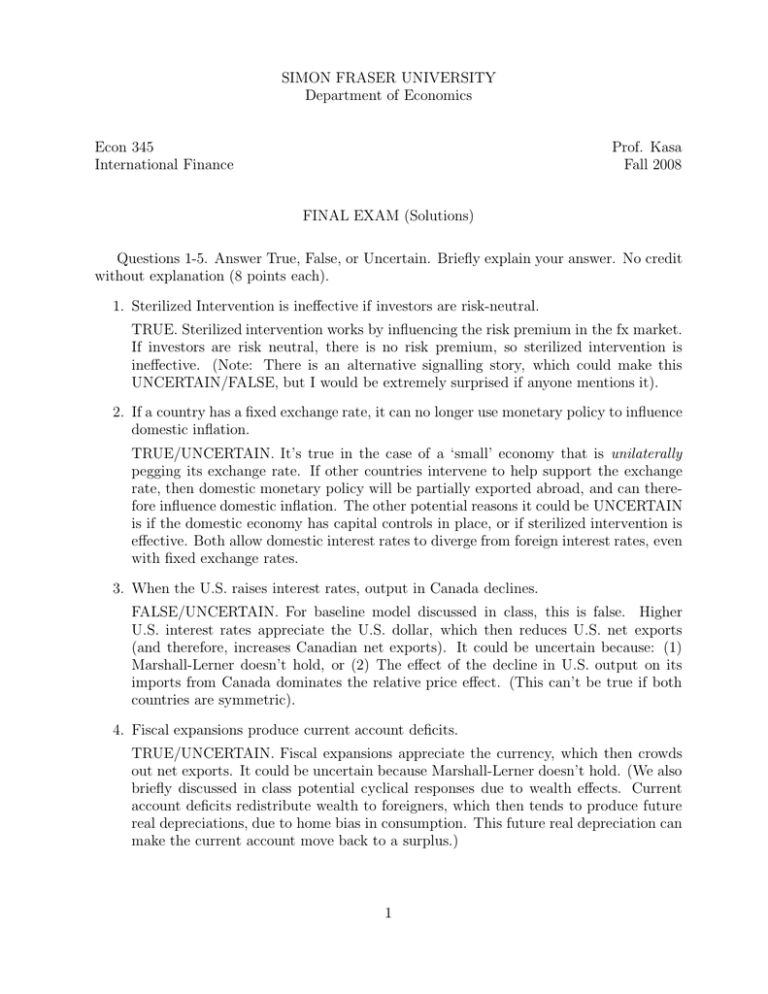
SIMON FRASER UNIVERSITY Department of Economics Econ 345 International Finance Prof. Kasa Fall 2008 FINAL EXAM (Solutions) Questions 1-5. Answer True, False, or Uncertain. Briefly explain your answer. No credit without explanation (8 points each). 1. Sterilized Intervention is ineffective if investors are risk-neutral. TRUE. Sterilized intervention works by influencing the risk premium in the fx market. If investors are risk neutral, there is no risk premium, so sterilized intervention is ineffective. (Note: There is an alternative signalling story, which could make this UNCERTAIN/FALSE, but I would be extremely surprised if anyone mentions it). 2. If a country has a fixed exchange rate, it can no longer use monetary policy to influence domestic inflation. TRUE/UNCERTAIN. It’s true in the case of a ‘small’ economy that is unilaterally pegging its exchange rate. If other countries intervene to help support the exchange rate, then domestic monetary policy will be partially exported abroad, and can therefore influence domestic inflation. The other potential reasons it could be UNCERTAIN is if the domestic economy has capital controls in place, or if sterilized intervention is effective. Both allow domestic interest rates to diverge from foreign interest rates, even with fixed exchange rates. 3. When the U.S. raises interest rates, output in Canada declines. FALSE/UNCERTAIN. For baseline model discussed in class, this is false. Higher U.S. interest rates appreciate the U.S. dollar, which then reduces U.S. net exports (and therefore, increases Canadian net exports). It could be uncertain because: (1) Marshall-Lerner doesn’t hold, or (2) The effect of the decline in U.S. output on its imports from Canada dominates the relative price effect. (This can’t be true if both countries are symmetric). 4. Fiscal expansions produce current account deficits. TRUE/UNCERTAIN. Fiscal expansions appreciate the currency, which then crowds out net exports. It could be uncertain because Marshall-Lerner doesn’t hold. (We also briefly discussed in class potential cyclical responses due to wealth effects. Current account deficits redistribute wealth to foreigners, which then tends to produce future real depreciations, due to home bias in consumption. This future real depreciation can make the current account move back to a surplus.) 1 5. A devaluation causes the central bank to lose foreign exchange reserves. This is FALSE if the devaluation was unanticipated and not expected to recur. Surprise one-time devaluations cause the central bank to gain reserves. Of course, if a given devaluation makes investors suspect that another one is coming (as is often the case), then a devaluation might lead to a further loss of reserves, in which case it would be TRUE. The following questions are short answer. 6. (20 points). During the past several months we’ve seen the U.S. economy slip into a recession while the U.S. dollar appreciates. (a) Use the DD-AA model to interpret these events (i.e., which curve must be shifting?). Clearly, the AA curve must be shifting left. (b) Explain how this could be related to the ‘subprime crisis’. If households lose confidence in financial markets, they will increase money demand. This will cause a leftward shift in the AA curve. Also, attempts by banks to reduce leverage and raise reserve ratios, along with in increase in currency/deposit ratios, can lead to a drop in the money multiplier and an overall drop in the money supply. This would tend to reinforce a leftward shift in the AA curve. (c) The U.S. could respond to their recession by either fiscal expansion (e.g., increased government spending) or monetary expansion (e.g., lower interest rates). Which would be better for Canada? Why? Which would be better for China? Why? Since Canada has a flexible exchange rate vis-a-vis the U.S., and assuming Canada is also suffering from a recession, then clearly Canada would prefer a U.S. fiscal expansion. This will further appreciate the U.S. dollar and promote Canadian exports. In contrast, since China has a fixed exchange rate vis-a-vis the U.S., it would prefer a U.S. monetary expansion. Lower U.S. interest rates will force China to lower its interest rate, which is what is called for, assuming they are in a recession. A U.S. fiscal expansion will instead force China to raise interest rates, which will just make the recession worse in China. 7. (20 points). In his article, “The Global Capital Market: Benefactor or Menace?”, Maurice Obstfeld used the concept of an Open-Economy Trilemma to interpret the evolution of the international financial system. Briefly explain what this trilemma is. How does it help to explain the evolution of the international financial system? The Open-Economy Trilemma refers to inability to simultaneously guarantee three desirable policy outcomes: (1) Stable exchange rates, which promote international trade and investment, (2) An independent monetary policy that can respond to domestic macroeconomic conditions, and (3) Open capital markets, which enable a country to enjoy diversifcation and intertemporal gains from trade. The evolution of the international financial system has involved different choices about which one to sacrifice. During 2 the Gold Standard, monetary policy was not expected to play a role in stabilizing the business cycle. (This was before Keynes!). This was also an era of large net capital flows, especially between Britain and its former colonies, so it was desirable to maintain open capital markets. Hence, the Gold Standard opted for stable exchange rates and open capital markets, while sacrificing an independent monetary policy. The restoration of the Gold Standard after WWI was mishandled, which contributed to the Depression and led to exchange rate instability. In the meantime, Keynes had published the General Theory, and countercyclical macroeconomic policy became expected of governments. Hence, Bretton Woods resolved the choice by sacrificing open capital markets. Bretton Woods was sustained by capital controls. Finally, over time, these capital controls became harder and harder to enforce, while at the same time, people like Milton Friedman argued persuasively for flexible exchange rates. Hence, the modern era features flexible exchange rates, open capital markets, and independent monetary policy. (Please take a quick look at the Obstfeld article if you haven’t already done so. I just want them to regurgitate it. 8. (20 points). One of the key results of first-generation crisis models is to show how a major event, like a currency crisis, can occur without large shocks or news events. Explain why this can happen. (Hint: It might help to draw a graph illustrating the shadow exchange rate). I don’t have time to go through the details. Please see lecture notes 8B. For full credit, they should put down the graph of the shadow exchange rate, and explain why it slopes up. They should also clearly state the ‘no arbitrage’ logic that forces the attack to occur as soon as (but not before) the shadow rate hits the pegged rate. The last page of the notes (pg 10) explains why this model can explain how crises occur without major news events. 3
